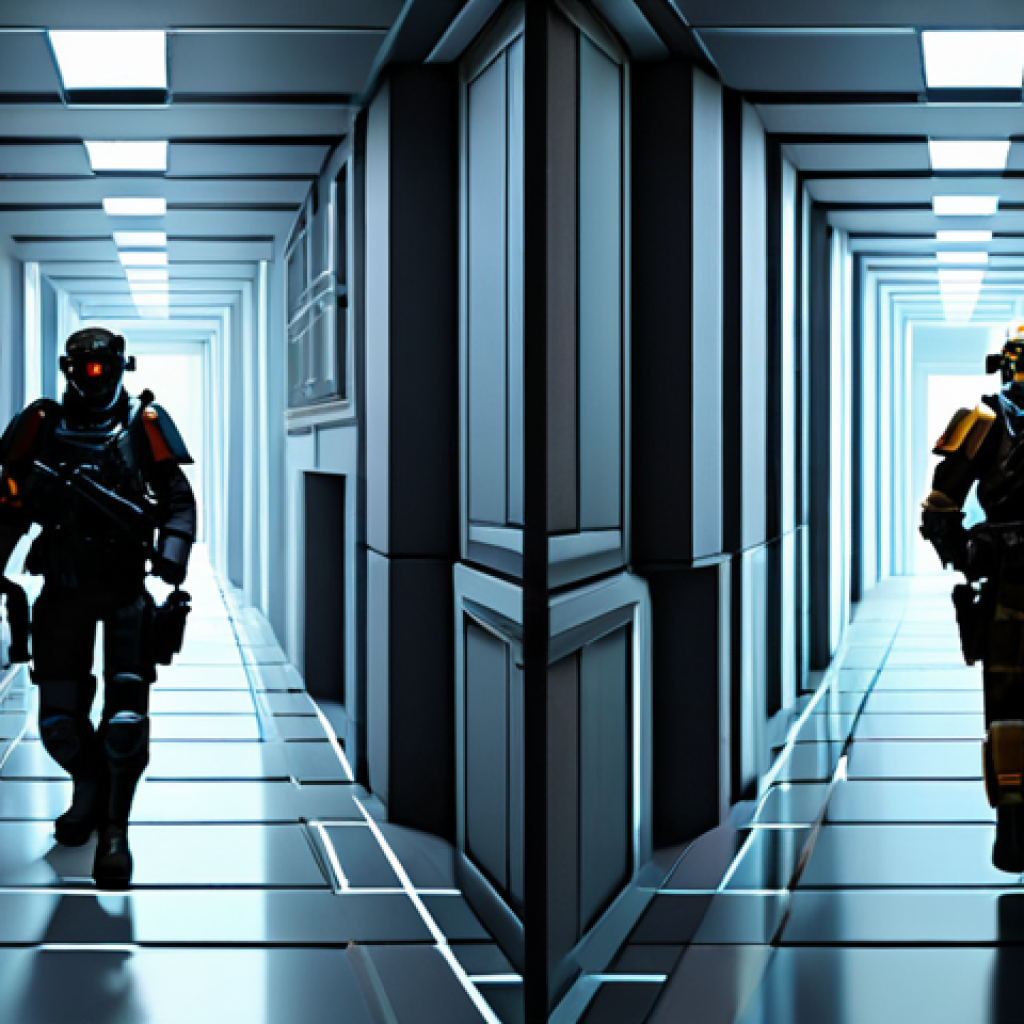Remember that first time you truly felt *immersed* in an FPS, the chilling silence before an ambush, the heart-pounding rush of a perfectly executed headshot?
For decades, the First-Person Shooter genre has been more than just a game; it’s been a relentless laboratory for innovation, constantly pushing the boundaries of what’s possible in interactive entertainment.
From groundbreaking movement mechanics to intricate narrative design, these titles continually redefine our expectations with every release. It’s truly incredible how far we’ve come, moving beyond simple arcade shooters into vast, living worlds.
We’re not just playing; we’re experiencing, evolving alongside the developers. Let’s delve into the specifics below. As an avid gamer who’s witnessed the genre’s evolution firsthand, I can tell you there’s a palpable thrill in seeing developers dare to break the mold.
We’re talking about games that didn’t just iterate, but fundamentally shifted our perception of what an FPS could be. Think about the sheer audacity of *Doom* introducing a sense of true 3D space, or *Quake* popularizing competitive online multiplayer with its lightning-fast movement.
Then came titles like *Half-Life*, weaving narrative depth into a seamless first-person perspective, making us *feel* like Gordon Freeman rather than just controlling him.
More recently, the ingenuity seen in *Apex Legends*’ unparalleled ping system revolutionized team communication without voice chat, while *Valorant*’s robust anti-cheat measures and tick-rate servers set new industry standards for competitive integrity.
These aren’t just minor tweaks; they’re monumental leaps that directly impact our gameplay experience, often sparking intense community discussions about fairness and innovation.
Looking forward, the future of FPS games, as hinted by current trends and whispers from cutting-edge R&D, is truly mind-bending. Imagine AI-driven antagonists that dynamically learn your playstyle, adapting their strategies in real-time, or procedurally generated levels that offer endless, unique combat scenarios, keeping every session fresh.
We’re already seeing hints of this with sophisticated neural networks used in game development. Furthermore, the push for deeper haptic feedback and more accessible VR/AR integration promises to blur the line between virtual and reality, making every explosion and bullet impact incredibly visceral.
The ongoing debate surrounding monetization models, from battle passes to cosmetic microtransactions, will undoubtedly continue to evolve, hopefully towards systems that prioritize player value over aggressive revenue generation.
Cloud gaming also stands poised to democratize access, potentially allowing anyone with an internet connection to jump into high-fidelity competitive arenas, fostering an even larger, more diverse global community.
The potential for these innovations to reshape how we interact with, and even *feel*, our games is immense, promising an era where the lines between player and world become almost indistinguishable.
Pioneering Immersive Worlds and Fundamental Mechanics

Stepping back in time, I can still vividly recall the sheer awe of experiencing the earliest FPS titles. It wasn’t just about shooting; it was about the thrill of *being there*, navigating those pixelated corridors, and feeling the tangible threat around every corner.
Games like *Wolfenstein 3D* didn’t just give us a gun; they gave us a viewpoint into a digital world that felt revolutionary. Then came *Doom*, which for me, was an absolute game-changer.
It wasn’t just a simple 2.5D maze; it pushed boundaries with its hellish aesthetics, fast-paced action, and the introduction of a genuine sense of height and verticality, even if it was somewhat faked.
This was before 3D acceleration cards were common, and the raw ingenuity behind making those worlds feel as dynamic as they did was simply mind-blowing.
I remember spending countless hours just exploring, discovering secret passages, and marveling at the technical wizardry. This era truly laid the groundwork for everything that came after, establishing the core tenets of movement, combat, and environmental interaction that we still recognize today.
It was raw, unfiltered fun, a primal scream of digital violence and exhilarating exploration.
The Genesis of Movement and Space
Before the advent of true 3D engines, developers were master illusionists, bending perspective and clever rendering tricks to make us believe we were moving through rich, three-dimensional spaces.
I remember the clunky but exhilarating movement in early games, a stark contrast to today’s smooth parkour and wall-runs. It was about mastering the strafe, understanding the subtle nuances of pixel-perfect hitboxes, and learning the labyrinthine level designs by heart.
The feeling of being confined yet empowered in these early digital arenas was unique. The very act of navigating these spaces, even with their limitations, created a powerful sense of presence that was unparalleled at the time.
My own hands-on experience during these formative years taught me how foundational these seemingly simple mechanics were. They weren’t just features; they were the very language of interacting with these new, digital realities.
We were all learning a new grammar of play.
Weaponry and the Arcade Rush
From the iconic chainsaw in *Doom* to the satisfying ‘pew-pew’ of the Shotgun, early FPS games nailed the visceral feedback of weaponry. Each shot felt impactful, and the distinct sounds and visual effects, however primitive, conveyed a sense of power.
It wasn’t about realism; it was about the immediate, gratifying arcade rush. I recall the intense pleasure of finding a new, more powerful weapon, knowing it would completely alter my approach to the next wave of enemies.
This focus on immediate gratification and potent tools of destruction was a brilliant design choice, keeping players hooked and constantly seeking that next explosive encounter.
It cemented the idea that the weapon wasn’t just a tool, but an extension of the player’s will, a conduit for exhilarating digital mayhem.
The Ascent of Narrative and Emotional Depth
As the technology matured, so did the ambition of game developers. It wasn’t enough to just shoot things; players began craving a reason *why*. This shift marked a profound turning point for the genre, transforming what were once glorified shooting galleries into compelling, story-driven experiences.
The advent of titles like *Half-Life* was a revelation for me. I remember being utterly captivated by its seamless narrative delivery, the way the story unfolded through environmental cues and character interactions rather than jarring cutscenes.
It pulled you into the shoes of Gordon Freeman, making you feel the urgency and danger of his situation in a way no game had before. This wasn’t just a game; it was an interactive narrative, a truly immersive journey that demonstrated the incredible power of the first-person perspective to tell deeply personal and engaging stories.
It felt like walking through a movie, but one where every decision, every movement, was *mine*.
Seamless Storytelling and Environmental Clues
One of the most impactful innovations for me was the move away from traditional cutscenes towards environmental storytelling. Games started to whisper their narratives through details in the world itself—graffiti on walls, discarded journals, subtle changes in the environment reacting to your actions.
This approach respects the player’s intelligence, inviting them to piece together the lore and story at their own pace. I’ve personally found this method far more engaging, as it fosters a deeper connection to the game world.
It’s not just about being told a story; it’s about *discovering* it, feeling like an archaeologist unearthing ancient secrets. This subtly makes the player feel more integral to the narrative, enhancing the sense of agency and immersion far beyond what static cinematics could ever achieve.
Character Interaction and Emotional Resonance
Beyond environmental storytelling, the evolution of character interaction brought a new layer of emotional resonance to FPS games. Moving from silent protagonists to characters with complex personalities and relationships, these games started to tug at our heartstrings.
I remember moments in games where I genuinely felt a bond with an NPC, or a surge of anger at an antagonist, which was a testament to the power of well-written dialogue and compelling voice acting.
This human element, the feeling of shared struggle or camaraderie, elevated the genre beyond mere action. It transformed the player from a simple shooter into an active participant in a living, breathing drama, making the victories sweeter and the losses far more poignant.
The emotional investment I’ve developed in some of these narratives has kept me thinking about them long after the credits rolled.
Forging Competitive Battlegrounds and Esport Legacies
The true explosive growth of the FPS genre, beyond its single-player triumphs, came with the undeniable rise of competitive online multiplayer. I remember the very early days of dial-up connections, the thrill of finally connecting to a server, and the immediate, chaotic joy of facing off against other real players.
It was a completely different beast than AI opponents, unpredictable and infinitely more challenging. Games like *Quake* and *Counter-Strike* didn’t just introduce multiplayer; they forged the very blueprints for competitive online gaming.
The precision, the strategies, the intense pressure of knowing another human was on the other side – it was exhilarating. This laid the foundation for what would become a global phenomenon, cultivating vibrant communities and eventually blossoming into the massive esports industry we see today.
The late-night sessions with friends, the shouting over headsets, the sheer elation of a clutch play – those memories are etched into my gaming history.
The Rise of Skill-Based Arenas
Early competitive FPS games weren’t just about raw aim; they were about mastering movement, map knowledge, and tactical decision-making. I spent countless hours in *Quake 3 Arena*, learning the intricate jump pads, the weapon spawn timings, and the subtle art of “rocket jumping.” It wasn’t just about shooting; it was about outmaneuvering, outsmarting, and truly outplaying your opponent.
This focus on skill expression created incredibly high ceilings for mastery, rewarding dedication and practice. The feeling of executing a perfect maneuver, knowing you had outwitted a human opponent, was incredibly satisfying.
It fostered a vibrant subculture of competitive players who pushed the boundaries of what was possible within these digital arenas, setting the stage for professional gaming.
Esports Integration and Global Communities
The evolution from casual online matches to professional esports was a gradual but monumental shift. Titles like *Counter-Strike: Global Offensive* and *Call of Duty* transformed into legitimate professional sports, with dedicated leagues, massive prize pools, and global fan bases.
I’ve personally watched numerous tournaments, captivated by the high-stakes plays and the incredible coordination of professional teams. The level of strategy and execution on display is often breathtaking, making these games not just fun to play, but also incredibly compelling to watch.
This global community, fueled by passionate players and viewers, has solidified the FPS genre’s position as a cornerstone of competitive entertainment.
Revolutionizing Visuals, Audio, and Player Experience
Beyond raw gameplay, the sensory experience of an FPS has evolved dramatically, pulling us deeper into virtual worlds. I remember the jaw-dropping moment when games started incorporating advanced lighting effects, making environments feel truly dynamic and alive.
The shift from pre-rendered backgrounds to fully interactive, destructible environments completely changed how I approached combat. No longer were we fighting in static boxes; we were engaged in dynamic spaces where walls could crumble and cover could be obliterated.
This evolution wasn’t just about making games look prettier; it was about enhancing immersion and providing new tactical possibilities. The sound design, too, has come a long way.
From simple directional cues to intricate soundscapes that convey minute details like the crunch of gravel underfoot or the subtle hiss of a faraway enemy, audio has become an incredibly powerful tool for world-building and competitive advantage.
The Evolution of Graphical Fidelity and Immersion
I still vividly remember the leap from pixelated characters to highly detailed models, from flat textures to realistic materials that reflected light.
Technologies like real-time ray tracing have completely transformed how light interacts with surfaces, creating incredibly lifelike scenes that can be genuinely breathtaking.
This relentless pursuit of graphical fidelity means that every bullet impact, every explosion, every character model feels more real, more visceral. It’s not just about visual splendor; it’s about reducing the cognitive load, allowing the player to feel more seamlessly connected to the game world.
The first time I truly felt *inside* a game world because of its visuals, not just playing it, was an unforgettable moment that cemented my belief in the power of this technology.
Mastering Auditory Cues and Spatial Sound
Perhaps less visible but equally impactful is the revolution in sound design. I recall the shift from basic stereo sound to advanced 3D spatial audio, where you could pinpoint an enemy’s exact location just by the sound of their footsteps.
This isn’t just an aesthetic improvement; it’s a critical gameplay mechanic in competitive titles. Knowing where an enemy is before you see them provides a crucial tactical advantage.
Beyond competitive play, immersive soundscapes build atmosphere, conveying the subtle hum of machinery in a sci-fi setting or the chilling silence of a horror-themed level.
For me, good sound design is often the unsung hero of immersion, pulling you into the world even when your eyes are focused elsewhere.
| Innovation Category | Early FPS (e.g., Doom, Quake) | Modern FPS (e.g., Apex Legends, Valorant) |
|---|---|---|
| Graphics & Visuals | Pixelated sprites, faux 3D, limited lighting. | Photorealistic textures, advanced lighting (ray tracing), dynamic environments, detailed character models. |
| Movement & Physics | Basic strafing, simple jumping, limited environmental interaction. | Fluid parkour, character-specific abilities, sophisticated physics (e.g., destrutible environments). |
| Sound Design | Basic mono/stereo sounds, limited spatial cues. | Hyper-realistic spatial audio (HRTF), environmental reverb, detailed weapon sounds, distinct character voice lines. |
| Narrative Delivery | Text-based storytelling, static cutscenes. | Seamless in-engine cutscenes, environmental storytelling, dynamic NPC interactions, branching dialogue. |
| Multiplayer Features | Basic server browsers, limited team play, peer-to-peer. | Dedicated servers, sophisticated matchmaking, robust anti-cheat, detailed communication systems (e.g., ping). |
The Evolving Landscape of Game Design and Player Agency
The FPS genre has never been content to stand still, constantly experimenting with core game design principles to give players more agency and unique experiences.
This has led to incredible diversification within the genre. From the open-world freedom of titles like *Far Cry* where I can choose my approach to missions, to the character-specific abilities and hero shooter dynamics of *Overwatch*, the sheer variety available now is astounding.
Developers are clearly pushing beyond simply point-and-shoot mechanics, integrating elements of RPGs, strategy games, and even puzzle-solving. This willingness to blend genres has kept the FPS fresh and exciting, constantly challenging my expectations about what a first-person experience can truly be.
It’s a testament to the creativity flowing through the industry, and it keeps us, the players, on our toes, eagerly anticipating the next big shift.
Character Abilities and Class-Based Combat
A significant departure from the classic “lone wolf” shooter has been the rise of character-specific abilities and class-based combat. Games like *Apex Legends* or *Overwatch* have introduced diverse rosters of “heroes” or “legends,” each with unique skills, ultimate abilities, and tactical roles.
This fundamentally changes the team dynamic, forcing players to think strategically about synergy and counter-picks rather than just raw firepower. I’ve found that mastering these diverse kits adds a whole new layer of complexity and replayability.
It feels less like a simple deathmatch and more like a tactical chess match, where individual skill combines with team coordination to achieve victory.
This innovation has undeniably broadened the appeal of the genre, bringing in players who might not typically gravitate towards traditional shooters.
Open-World Freedom and Emergent Gameplay
The integration of expansive open worlds into the FPS framework has been another exciting evolution. Instead of linear levels, games now offer vast, explorable environments filled with side quests, dynamic events, and countless ways to approach objectives.
I’ve spent countless hours in games like *Far Cry* or *Borderlands*, getting lost in their sprawling maps, creating my own adventures, and experiencing truly emergent gameplay moments – unexpected encounters or hilarious physics glitches that turn a routine mission into an unforgettable anecdote.
This freedom allows players to craft their own unique stories within the game, greatly enhancing replayability and the sense of player agency. It feels less like a guided tour and more like an untamed wilderness, ripe for exploration and personalized mayhem.
Gazing Into the Future: AI, VR, and Boundless Possibilities
The trends we’re currently witnessing, coupled with the rapid advancements in technology, paint a truly mind-bending picture for the future of FPS games.
We’re on the cusp of experiencing levels of immersion and dynamic gameplay that were once confined to science fiction. Imagine AI opponents that don’t just follow pre-programmed paths, but truly learn from your playstyle, adapting their strategies in real-time to challenge you in unprecedented ways.
The thought alone sends shivers down my spine – the ultimate test of skill against an ever-evolving digital mind. And then there’s the ongoing march of virtual and augmented reality.
While still finding their footing, these technologies promise to completely dissolve the screen, placing us directly *inside* the game world. I’ve had glimpses of this future with early VR shooters, and even with their current limitations, the sense of presence is undeniable.
The potential is immense, suggesting an era where the lines between player and world become almost indistinguishable.
Adaptive AI and Dynamic Challenges
The promise of truly adaptive AI is one of the most exciting prospects for the future of FPS. We’re moving beyond simple difficulty settings to systems where enemies can learn your preferred weapons, your movement patterns, and even your common tactical choices.
Imagine a boss battle where the AI dynamically adjusts its strategy based on your previous attempts, or a squad of enemies that intelligently flank you after observing your predictable cover habits.
This would revolutionize single-player experiences, ensuring every playthrough feels fresh and challenging, providing an unparalleled sense of accomplishment when you finally outwit a truly intelligent opponent.
For me, this is where the genre could find its next major leap in compelling gameplay.
Immersive VR/AR Integration and Haptic Feedback
Virtual Reality (VR) and Augmented Reality (AR) are poised to dramatically deepen the immersion of FPS games. While still nascent, the ability to physically aim, duck behind cover, and experience a truly 360-degree battlefield is revolutionary.
I’ve personally found VR shooters to be incredibly intense, pushing my spatial awareness and reflexes in ways traditional games cannot. Furthermore, advances in haptic feedback promise to make every in-game action feel more tangible, from the recoil of a powerful rifle to the impact of a grenade blast vibrating through your hands.
This multi-sensory engagement will blur the lines between the digital and physical, offering a visceral gaming experience that could truly redefine what it means to “play” an FPS.
It’s an exciting, albeit sometimes dizzying, frontier.
Cloud Gaming and Accessibility
Finally, the rise of cloud gaming platforms holds the potential to democratize access to high-fidelity FPS experiences like never before. The idea that anyone with a decent internet connection could instantly jump into a graphically intensive, competitive shooter without needing expensive hardware is transformative.
This could massively expand the player base, fostering even larger and more diverse global communities. While there are still challenges to overcome, particularly with latency in fast-paced shooters, the long-term vision of truly frictionless access is incredibly compelling.
It promises a future where the barrier to entry is lowered, allowing more players than ever to experience the thrill of the first-person shooter.
Closing Thoughts
Reflecting on this incredible journey, it’s clear the First-Person Shooter genre has been far more than just a series of games; it’s been a constantly evolving canvas for innovation, storytelling, and competitive spirit. From the raw, visceral thrill of early pixelated worlds to the hyper-realistic battlegrounds and intricate narratives of today, FPS games have consistently pushed the boundaries of interactive entertainment. My own decades of experience playing these titles have shown me that this genre, perhaps more than any other, embodies the relentless pursuit of immersion and player engagement. It’s been a privilege to witness its evolution, and I truly believe the most exciting chapters are still yet to be written.
Useful Information
1. Invest in Your Setup: For serious FPS players, a high refresh rate monitor, a responsive gaming mouse, and a quality headset with good spatial audio can provide a significant competitive edge and massively boost your immersion. These aren’t just luxuries; they’re tools that truly make a difference in your reaction time and situational awareness.
2. Join the Community: Don’t play in isolation! Engaging with other players through online forums, Discord servers, or social media groups can help you find teammates, learn new strategies, and discover hidden gems within the genre. Many games thrive on their communities, offering shared experiences and opportunities for growth.
3. Practice Beyond Matches: While playing actual games is crucial, consider using dedicated aim trainers (like KovaaK’s or Aim Lab) or game-specific practice modes. Focusing on specific mechanics like flick shots, tracking, or recoil control in a low-pressure environment can dramatically accelerate your skill improvement.
4. Explore Subgenres: The FPS landscape is incredibly diverse. If a traditional arena shooter isn’t your cup of tea, perhaps a tactical shooter like *Valorant*, an open-world experience like *Borderlands*, or a hero shooter like *Overwatch* might be. Each subgenre offers a unique blend of mechanics and challenges, so don’t limit yourself.
5. Appreciate the Narrative: Even in games primarily known for their multiplayer, take some time to delve into the lore and story. Many FPS titles, from *Destiny 2* to *Apex Legends*, have rich backstories and character arcs that add significant depth and emotional resonance, making your engagement with the game world far more meaningful.
Key Takeaways
The First-Person Shooter genre has undergone a monumental transformation, evolving from rudimentary 2.5D experiences to hyper-realistic, narratively rich, and deeply competitive ecosystems. This journey has been driven by relentless technological advancements in visuals and audio, a growing emphasis on compelling storytelling, and the explosive growth of online multiplayer and professional esports. Simultaneously, game design has diversified, introducing intricate character abilities and expansive open worlds, promising an even more immersive and dynamic future with AI, VR, and cloud gaming at the forefront. It’s a genre that consistently reinvents itself, always pushing the boundaries of interactive entertainment.
Frequently Asked Questions (FAQ) 📖
Q: What early FPS titles truly revolutionized the genre and how did they achieve it?
A: Oh man, if I think back, it’s those early pioneers that really set the stage. Doom was just… wow.
Suddenly you weren’t just moving left and right, but experiencing a true sense of space, that claustrophobic dread in those corridors. It felt visceral!
Then Quake burst onto the scene, practically inventing what competitive online multiplayer felt like with its crazy fast pace; you just had to be precise.
And Half-Life? That game didn’t just give us a character, it made us be Gordon Freeman, weaving an actual story into the gameplay so seamlessly that it blurred the lines between cutscene and action.
Each one was a genuine ‘aha!’ moment that shifted how we thought about what an FPS could even be.
Q: Beyond just graphics, what modern FPS innovations have genuinely changed how we play or experience these games?
A: It’s easy to get caught up in how pretty games look now, but for me, it’s the subtle genius that truly impacts gameplay. Take Apex Legends’ ping system – seriously, that thing revolutionized team communication without needing voice chat.
You could perfectly coordinate a push, mark enemies, or call out loot without saying a word, which was a godsend for players who couldn’t or preferred not to use a mic.
And Valorant’s commitment to competitive integrity with its robust anti-cheat and high tick-rate servers? That wasn’t just a feature; it was a statement.
It made you feel like every match was truly fair, that your skills, not server lag or cheaters, decided the outcome. These aren’t just minor tweaks; they fundamentally reshaped how we interact and compete.
Q: Looking ahead, what are some of the most exciting, even mind-bending, innovations we can expect in future FPS titles?
A: Oh, the future of FPS is where my gamer heart really gets pumping! I’m absolutely fascinated by the potential of AI-driven antagonists that learn from your playstyle.
Imagine an enemy that actually adapts to your flanking routes or snipes you after you consistently miss your shots—that’s terrifyingly cool and would keep every single encounter fresh.
And the talk of deeper haptic feedback combined with more accessible VR/AR integration? It promises to make every explosion rattle through you, every bullet impact feel incredibly real.
We’re talking about an era where the boundary between player and the virtual world could truly blur, creating experiences so immersive they might just give you goosebumps.
It’s not just about what we’ll play, but how we’ll feel it.
📚 References
Wikipedia Encyclopedia
구글 검색 결과
구글 검색 결과
구글 검색 결과
구글 검색 결과
구글 검색 결과





